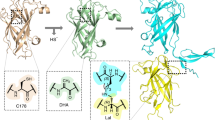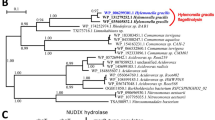Abstract
Spirochaetes are bacteria responsible for several serious diseases, including Lyme disease (Borrelia burgdorferi), syphilis (Treponema pallidum) and leptospirosis (Leptospira interrogans), and contribute to periodontal diseases (Treponema denticola)1. These spirochaetes employ an unusual form of flagella-based motility necessary for pathogenicity; indeed, spirochaete flagella (periplasmic flagella) reside and rotate within the periplasmic space2–11. The universal joint or hook that links the rotary motor to the filament is composed of ∼120–130 FlgE proteins, which in spirochaetes form an unusually stable, high-molecular-weight complex9,12–17. In other bacteria, the hook can be readily dissociated by treatments such as heat18. In contrast, spirochaete hooks are resistant to these treatments, and several lines of evidence indicate that the high-molecular-weight complex is the consequence of covalent crosslinking12,13,17. Here, we show that T. denticola FlgE self-catalyses an interpeptide crosslinking reaction between conserved lysine and cysteine, resulting in the formation of an unusual lysinoalanine adduct that polymerizes the hook subunits. Lysinoalanine crosslinks are not needed for flagellar assembly, but they are required for cell motility and hence infection. The self-catalytic nature of FlgE crosslinking has important implications for protein engineering, and its sensitivity to chemical inhibitors provides a new avenue for the development of antimicrobials targeting spirochaetes.
This is a preview of subscription content, access via your institution
Access options
Subscribe to this journal
Receive 12 digital issues and online access to articles
$119.00 per year
only $9.92 per issue
Buy this article
- Purchase on Springer Link
- Instant access to full article PDF
Prices may be subject to local taxes which are calculated during checkout




Similar content being viewed by others
References
Paster, B. J. in Bergey's Manuel of Systematic Bacteriology Vol. 4 (eds Krieg, N. R. et al.), 471–566 (Springer, 2011).
Sultan, S. Z. et al. Motility is crucial for the infectious life cycle of Borrelia burgdorferi. Infect. Immun. 81, 2012–2021 (2013).
Li, C., Xu, H., Zhang, K. & Liang, F. T. Inactivation of a putative flagellar motor switch protein FliG1 prevents Borrelia burgdorferi from swimming in highly viscous media and blocks its infectivity. Mol. Microbiol. 75, 1563–1576 (2010).
Sze, C. W., Zhang, K., Kariu, T., Pal, U. & Li, C. Borrelia burgdorferi needs chemotaxis to establish infection in mammals and to accomplish its enzootic cycle. Infect. Immun. 80, 2485–2492 (2012).
Lambert, A. et al. FlaA proteins in Leptospira interrogans are essential for motility and virulence but are not required for formation of the flagellum sheath. Infect. Immun. 80, 2019–2025 (2012).
Liao, S. et al. Inactivation of the fliY gene encoding a flagellar motor switch protein attenuates mobility and virulence of Leptospira interrogans strain Lai. BMC Microbiol. 9, 253 (2009).
Sultan, S. Z. et al. Motor rotation is essential for the formation of the periplasmic flagellar ribbon, cellular morphology, and Borrelia burgdorferi persistence within Ixodes scapularis tick and murine hosts. Infect. Immun. 83, 1765–1777 (2015).
Charon, N. W. & Goldstein, S. F. Genetics of motility and chemotaxis of a fascinating group of bacteria: the spirochetes. Annu. Rev. Genet. 36, 47–73 (2002).
Charon, N. W. et al. The unique paradigm of spirochete motility. Annu. Rev. Microbiol. 66, 349–370 (2012).
Wolgemuth, C. W. Flagellar motility of the pathogenic spirochetes. Semin. Cell Dev. Biol. 46, 104–112 (2015).
Wunder, E. A. et al. A novel flagellar sheath protein, FcpA, determines filament coiling, translational motility and virulence for the Leptospira spirochete. Mol. Microbiol. http://dx.doi.org/10.1111/mmi.13403 (24 May 2016).
Miller, K. A. et al. Initial characterization of the FlgE hook high molecular weight complex of Borrelia burgdorferi. PLoS ONE 9, e98338 (2014).
Limberger, R. J., Slivienski, L. L. & Samsonoff, W. A. Genetic and biochemical analysis of the flagellar hook of Treponema phagedenis. J. Bacteriol. 176, 3631–3637 (1994).
Limberger, R. J., Slivienski, L. L., Izard, J. & Samsonoff, W. A. Insertional inactivation of Treponema denticola tap1 results in a nonmotile mutant with elongated flagellar hooks. J. Bacteriol. 181, 3743–3750 (1999).
Chi, B., Limberger, R. J. & Kuramitsu, H. K. Complementation of a Treponema denticola flgE mutant with a novel coumermycin A1-resistant T. denticola shuttle vector system. Infect. Immun. 70, 2233–2237 (2002).
Limberger, R. J., Slivienski, L. L., El-Afandi, M. C. T. & Dantuono, L. A. Organization, transcription, and expression of the 5' region of the fla operon of Treponema phagedenis and Treponema pallidum. J. Bacteriol. 178, 4628–4634 (1996).
Sal, M. S. et al. Borrelia burgdorferi uniquely regulates its motility genes and has an intricate flagellar hook-basal body structure. J. Bacteriol. 190, 1912–1921 (2008).
Jones, C. J., Macnab, R. M., Okino, H. & Aizawa, S. Stoichiometric analysis of the flagellar hook-(basal-body) complex of Salmonella typhimurium. J. Mol. Biol. 212, 377–387 (1990).
Popa, M. P., McKelvey, T. A., Hempel, J. & Hendrix, R. W. Bacteriophage HK97 structure: wholesale covalent cross-linking between the major head shell subunits. J. Virol. 65, 3227–3237 (1991).
Miller, K. A. Characterization of the Unique Flagellar Hook Structure of the Spirochetes Borrelia burgdorferi and Treponema denticola PhD thesis (West Virginia Univ., 2013).
Friedman, M. Chemistry, biochemistry, nutrition, and microbiology of lysinoalanine, lanthionine, and histidinoalanine in food and other proteins. J. Agric. Food Chem. 47, 1295–1319 (1999).
Fujii, T., Kato, T. & Namba, K. Specific arrangement of alpha-helical coiled coils in the core domain of the bacterial flagellar hook for the universal joint function. Structure 17, 1485–1493 (2009).
Ruby, J. D. et al. Relationship of Treponema denticola periplasmic flagella to irregular cell morphology. J. Bacteriol. 179, 1628–1635 (1997).
Li, H., Ruby, J., Charon, N. & Kuramitsu, H. Gene inactivation in the oral spirochete Treponema denticola: construction of a flgE mutant. J. Bacteriol. 178, 3664–3667 (1996).
Son, K., Guasto, J. S. & Stocker, R. Bacteria can exploit a flagellar buckling instability to change direction. Nature Phys. 9, 494–498 (2013).
Duda, R. L. et al. Structure and energetics of encapsidated DNA in bacteriophage HK97 studied by scanning calorimetry and cryo-electron microscopy. J. Mol. Biol. 391, 471–483 (2009).
Baker, E. N., Squire, C. J. & Young, P. G. Self-generated covalent cross-links in the cell-surface adhesins of Gram-positive bacteria. Biochem. Soc. Trans. 43, 787–794 (2015).
Monroe, A. & Setlow, P. Localization of the transglutaminase cross-linking sites in the Bacillus subtilis spore coat protein GerQ. J. Bacteriol. 188, 7609–7616 (2006).
Okesli, A., Cooper, L. E., Fogle, E. J. & van der Donk, W. A. Nine post-translational modifications during the biosynthesis of cinnamycin. J. Am. Chem. Soc. 133, 13753–13760 (2011).
Orth, R., O'Brien-Simpson, N., Dashper, S., Walsh, K. & Reynolds, E. An efficient method for enumerating oral spirochetes using flow cytometry. J. Microbiol. Meth. 80, 123–128 (2010).
Bian, J., Shen, H., Tu, Y., Yu, A. & Li, C. The riboswitch regulates a thiamine pyrophosphate ABC transporter of the oral spirochete Treponema denticola. J. Bacteriol. 193, 3912–3922 (2011).
McIntosh, L. P. et al. Proton NMR measurements of bacteriophage T4 lysozyme aided by 15N isotopic labeling: structural and dynamic studies of larger proteins. Proc. Natl Acad. Sci. USA 84, 1244–1248 (1987).
Vonderviszt, F., Zavodszky, P., Ishimura, M., Uedaira, H. & Namba, K. Structural organization and assembly of flagellar hook protein from Salmonella typhimurium. J. Mol. Biol. 251, 520–532 (1995).
Bian, J., Fenno, J. C. & Li, C. Development of a modified gentamicin resistance cassette for genetic manipulation of the oral spirochete Treponema denticola. Appl. Environ. Microbiol. 78, 2059–2062 (2012).
Bian, J. & Li, C. Disruption of a type II endonuclease (TDE0911) enables Treponema denticola ATCC 35405 to accept an unmethylated shuttle vector. Appl. Environ. Microbiol. 77, 4573–4578 (2011).
Goetting-Minesky, M. P. & Fenno, J. C. A simplified erythromycin resistance cassette for Treponema denticola mutagenesis. J. Microbiol. Meth. 83, 66–68 (2010).
Laemmli, U. K. Cleavage of structural proteins during the assembly of the head of bacteriophage T4. Nature 227, 680–685 (1970).
Limberger, R. J. & Charon, N. W. Antiserum to the 33,000-dalton periplasmic-flagellum protein of ‘Treponema phagedenis’ reacts with other treponemes and Spirochaeta aurantia. J. Bacteriol. 168, 1030–1032 (1986).
Bian, J., Liu, X., Cheng, Y. Q. & Li, C. Inactivation of cyclic di-GMP binding protein TDE0214 affects the motility, biofilm formation, and virulence of Treponema denticola. J. Bacteriol. 195, 3897–3905 (2013).
Yang, Y., Thannhauser, T. W., Li, L. & Zhang, S. Development of an integrated approach for evaluation of 2-D gel image analysis: impact of multiple proteins in single spots on comparative proteomics in conventional 2-D gel/MALDI workflow. Electrophoresis 28, 2080–2094 (2007).
Yang, Y. et al. Evaluation of different multidimensional LC-MS/MS pipelines for isobaric tags for relative and absolute quantitation (iTRAQ)-based proteomic analysis of potato tubers in response to cold storage. J. Proteome Res. 10, 4647–4660 (2011).
Hochrainer, K., Racchumi, G., Zhang, S., Iadecola, C. & Anrather, J. Monoubiquitination of nuclear RelA negatively regulates NF-κB activity independent of proteasomal degradation. Cell. Mol. Life Sci. 69, 2057–2073 (2012).
Acknowledgements
Funding was provided by the National Institutes of Health (R01-DE023431, to N.C., M.M. and C.L.), R01 GM064664 (to B.C.), R01-AI087946 (to J.L.) and R01-DE023080 and R01-AI078958 (to C.L). J.L. was also supported by grant AU-1714 from the Welch Foundation. The authors thank B. Bachert, M. Barbier, R. Duda, R. Hendrix, D. McNitt, S. Norris, R. Silversmith and R. Sircar for suggestions, technical assistance and support. The findings and conclusions in this article are those of the authors and do not necessarily represent the official position of the Centers for Disease Control and Prevention or the National Institute for Occupational Safety and Health.
Author information
Authors and Affiliations
Contributions
N.W.C. and M.R.M. designed the project. B.R.C., N.W.C., C.L, J.L. and M.R.M. wrote the manuscript. P.S.C., N.W.C., B.R.C., J.M.H, M.E.J., C.L., J.L., K.A.M. and M.R.M. designed the experiments. J.B., A.C., J.L., K.A.M., M.R.M., M.E.J., M.L. and S.Z. carried out experiments.
Corresponding author
Ethics declarations
Competing interests
The authors declare no competing financial interests.
Supplementary information
Supplementary information
Supplementary Figures 1–12, Supplementary Tables 1–6, Supplementary Video Legends 1–4 (PDF 3951 kb)
Supplementary Video 1
Cells WT T. denticola in 1% methylcelluose. (MOV 5395 kb)
Supplementary Video 2
Cells of mutant δflgE in 1% methylcellulose. (MOV 12170 kb)
Supplementary Video 3
Cells of substitution mutant TdC178A in 1% methylcellulose. (MOV 5836 kb)
Supplementary Video 4
Cells of substitution mutant TdK169A in 1% methylcellulose. (MOV 7137 kb)
Rights and permissions
About this article
Cite this article
Miller, M., Miller, K., Bian, J. et al. Spirochaete flagella hook proteins self-catalyse a lysinoalanine covalent crosslink for motility. Nat Microbiol 1, 16134 (2016). https://doi.org/10.1038/nmicrobiol.2016.134
Received:
Accepted:
Published:
DOI: https://doi.org/10.1038/nmicrobiol.2016.134
This article is cited by
-
An overview of the structure and function of the flagellar hook FlgE protein
World Journal of Microbiology and Biotechnology (2023)
-
Structure and chemistry of lysinoalanine crosslinking in the spirochaete flagella hook
Nature Chemical Biology (2019)
-
Bacterial physiology: The ties that bind
Nature Microbiology (2016)



